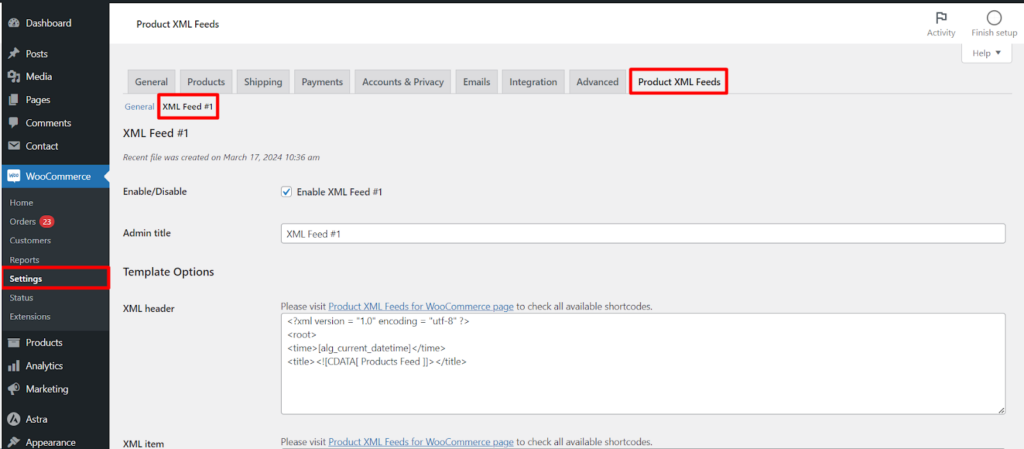This article explains the settings available for configuring individual product XML feeds within the Product XML Feeds for WooCommerce plugin. You can access these options by navigating to WooCommerce > Settings > Products and then clicking on the Product XML Feeds tab. Here, you’ll find separate tabs for each configured feed (e.g., Feed #1 ).
Understanding the Settings
Enable/Disable
- This toggle switch allows you to activate or deactivate the specific XML feed.
- A disabled feed won’t be generated or used.
Admin Title
- This field lets you define a custom name for the feed within the plugin interface.
- This name is for administrative purposes only and won’t be included in the actual feed file.
Template Options
These sections define the structure of your XML feed using shortcodes:
- XML header: This section specifies the opening tags and any necessary attributes for your feed file.
- XML item: This section defines the structure for each product entry within the feed, using shortcodes to represent product data like title, description, price, etc. You can find a list of available shortcodes on the Product XML Feeds for WooCommerce documentation page.
- Variation XML item (Optional): This section is relevant only if you’re including variations of variable products in your feed. It allows you to define a separate template for each product variation.
- XML footer: This section specifies the closing tags for your feed file.
Refer to the plugin documentation for detailed explanations and usage examples of each shortcode.
Hide XML tags if empty (Optional)
- This option allows you to hide specific XML tags from the feed if they contain no data.
- You can list comma-separated tags (e.g., “product, stock”) that should be omitted when their corresponding product data is empty.
Create Text Feed (Optional)
- This option enables the generation of a text-based version of your XML feed.
- The Text item section defines the structure of each product entry in the text format. Again, use shortcodes to represent product data.
Additional Notes
- You can create multiple product XML feeds with unique configurations.
- Experiment with different template options and shortcodes to achieve the desired structure for your feed files.
- Ensure your target platform (e.g., comparison shopping engine) recognizes the format and shortcodes used in your feed.
By effectively configuring these settings, you can create customized product XML feeds that cater to the specific requirements of different platforms you want to integrate with.
